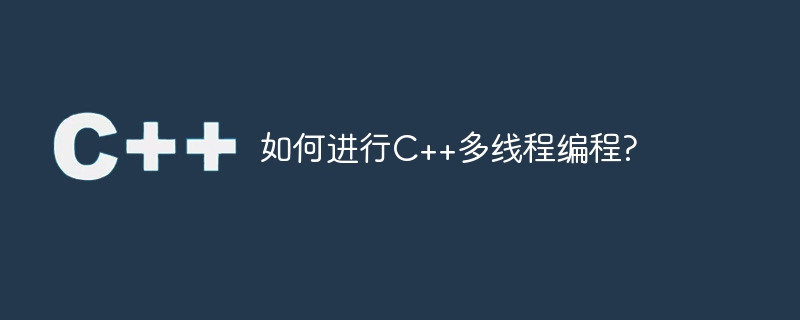Home >Backend Development >C++ >How to perform C++ multi-threaded programming?
How to perform C++ multi-threaded programming?
- PHPzOriginal
- 2023-11-04 08:05:091186browse

How to perform C multi-thread programming?
With the continuous development of computer hardware, multi-core processors have become the mainstream of modern computers. In order to fully utilize the performance of multi-core processors, multi-threaded programming becomes an important skill. C is a powerful programming language that also provides many tools and libraries for multi-threaded programming. This article will introduce how to do C multi-threaded programming.
- Introduce header files
Before using C for multi-thread programming, you need to introduce the corresponding header files. Before the C 11 standard, the <pthread.h></pthread.h> header file needed to be introduced to use the POSIX thread library. After the C 11 standard, you can directly use the <thread></thread> header file for multi-threaded programming.
- Creating a thread
In C, you can use the std::thread class to create a new thread. The basic syntax for creating a thread is as follows:
std::thread threadObj(function, arg1, arg2, ...);
Among them, function is a callable object, which can be a function pointer, a function object or a Lambda expression. arg1, arg2, ... are the parameters passed to function. In this way, you can easily create a new thread and pass it the code that needs to be executed.
- Thread execution
Threads created by using the std::thread class can call its join()Method to wait for thread execution to complete. The specific syntax is as follows:
threadObj.join();
This line of code will block the current thread until threadObj thread execution is completed.
- Passing parameters of threads
Threads created through the std::thread class can pass parameters in two ways. One is passing by reference and the other is passing by value. When passing by reference, you need to use the std::ref function to wrap the parameters. The specific syntax is as follows:
std::thread threadObj(function, std::ref(arg1), std::ref(arg2), ...);
When passing by reference, you need to pay attention to the life cycle of the thread. If the main thread ends before the thread execution ends, unpredictable behavior will occur.
- Use future to get the thread return value
Sometimes, we hope that a value can be returned after the thread execution ends. C provides the std::future class to accomplish this task. First, you need to create an asynchronous task by calling the std::async function, and then get the return value by calling the get() method. The specific syntax is as follows:
std::future<T> futureObj = std::async(std::launch::async, function, arg1, arg2, ...); T result = futureObj.get();
where T is the type of the return value. std::launch::asyncThe parameter specifies that the task is executed asynchronously, rather than delayed.
- Thread synchronization
In multi-thread programming, special attention needs to be paid to thread synchronization. When multiple threads access a resource at the same time, race conditions and data races may occur. C provides a variety of thread synchronization mechanisms, such as mutex locks (std::mutex), condition variables (std::condition_variable) and atomic operations (std: :atomic) etc. By using these mechanisms correctly, safe execution of multiple threads can be ensured.
The above is a basic introduction on how to perform C multi-threaded programming. Multithreaded programming is a complex and challenging skill that requires careful design and consideration of various concurrency scenarios. By using the multi-threaded programming tools and libraries provided by C, you can better utilize the computer's hardware resources and improve program execution efficiency and performance. I hope this article can help readers understand and apply C multi-threaded programming more deeply.
The above is the detailed content of How to perform C++ multi-threaded programming?. For more information, please follow other related articles on the PHP Chinese website!

